The Brain Mapping Foundation Awards a US Army colonel and 3 Distinguished U.S. and Canadian Scientists at its Gala in Toronto
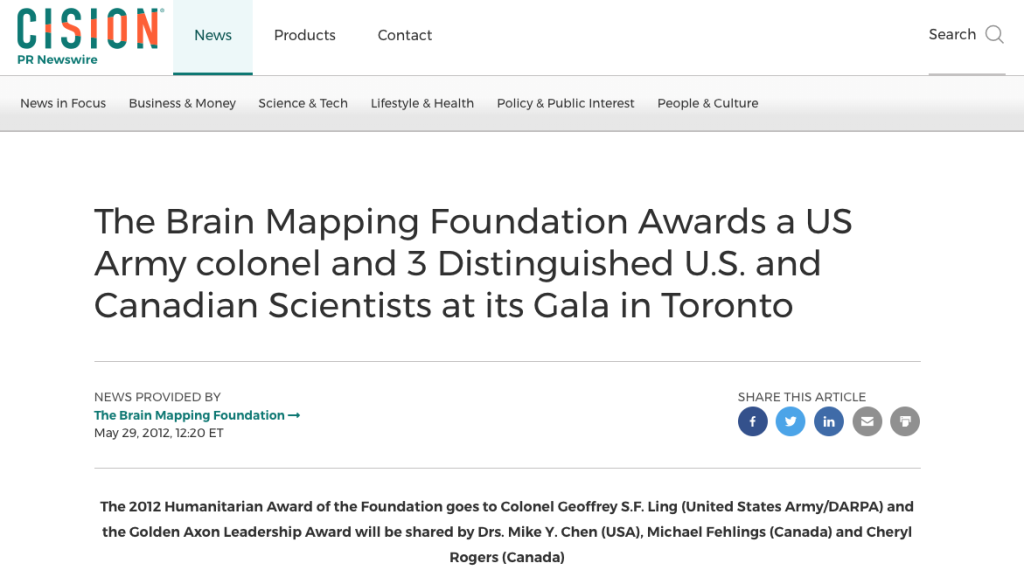
The 2012 Humanitarian Award of the Foundation goes to Colonel Geoffrey S.F. Ling (United States Army/DARPA) and the Golden Axon Leadership Award will be shared by Drs. Mike Y. Chen (USA), Michael Fehlings (Canada) and Cheryl Rogers (Canada) WEST HOLLYWOOD, Calif., May 29, 2012 /PRNewswire-USNewswire/ — The Brain Mapping Foundation is one of the world’s leading cutting-edge scientific organizations, focused on pushing the boundaries of science, technology and medicine in order to rapidly advance the treatment of neurological conditions such as traumatic brain injury, post-traumatic stress disorder, brain tumors and neurodegenerative diseases. The organization works closely with the Society for Brain Mapping and Therapeutics (SBMT) in order to help both wounded warriors and civilians afflicted with such neurological conditions. Each year the Brain Mapping Foundation recognizes humanitarian work done by leading scientists and members of SBMT who have brought the best technology, science and medicine to bear on the needs of the underserved as well as those in war-torn regions as part of a program called Global Physicians and Scientists (GPS). The Foundation honors such remarkable scientists with its Humanitarian Award. This year the award is presented to US Army Colonel Geoffrey S.F. Ling, M.D., Ph.D., the Chairman of the Department of Neurology at the U.S.’s only military medical school (Uniformed Services University) and Program Director at the Defense Advanced Research Projects Agency (DARPA). “Colonel Ling is a remarkable scientist and a compassionate physician who has helped train the finest doctors at USUHS,” said Ret. Vice Admiral Robinson, Director of GPS program of the Brain Mapping Foundation and member of the Board of SBMT. Colonel Ling has devoted his life to the care of patients regardless of their nationality, gender and race. He has treated over 300 U.S. and Iraqi Soldiers during his multiple deployments to Iraq and has been on the forefront of civilian care in Afghanistan. “80% of Dr. Ling’s patients in Afghanistan were local civilians and 20 % were children,” said Dr. Babak Kateb, President of the Brain Mapping Foundation and Chairman of the Board of SBMT. “Geoff is a physician scientist; this means that he interrogates the disorder before he treats it,” said Dr. Babak Kateb, President of the Brain Mapping Foundation, Chairman of the Board of SBMT and Research Scientist at the Department of Neurosurgery at Cedars-Sinai Medical Center in California; he continued, “Geoff has done a remarkable job of bringing the best science, medicine and technology to the wounded soldiers and local civilians in the warzone, as well as to the poor and needy in the remote corners of the world”. The Golden Axon Award of the Foundation is meant to highlight world-class leadership in neuroscience. The award is presented to individuals who have reached out to their local communities and helped both the Brain Mapping Foundation and SBMT with their mission, which in short is advancing multidisciplinary neuroscience research. Recipients of the 2012 Golden Axon Awards are Drs. Mike Y Chen, President of SBMT and Assistant professor of Neurosurgery at City of Hope Cancer Center in California, Michael Fehlings, Professor of Neurosurgery at Toronto University and Director of the Neuroscience Program at University of Toronto and Cheryl Rogers, Trade Commissioner at the Consulate of Canada, San Diego. Besides being a good scientist, Dr. Chen has been an excellent team leader who has built bridges that have resulted in the expansion of SBMT and the global advancement of clinical neuroscience research. “The Society and the field have significantly benefited from Dr. Chen’s contributions,” said Dr. Shouleh Nikzad, who is a Principal Member of the Staff, Technical Supervisor and Lead, Advanced UV/Vis/NIR Detector Arrays and Imaging Systems, and Nanoscience Group, as well as Lead, Strategic Initiative on Gigapixel Focal Plane Arrays and Deputy Lead, Advanced Imaging Systems , at the NASA-Jet Propulsion Laboratory, California Institute of Technology, Member of the Board of the Brain Mapping Foundation and Co-Chair of SBMT Award committee. Dr. Fehlings is a world-class neurosurgeon with multidisciplinary vision. He showed his remarkable leadership skills as local chairman of the 9th Annual World Congress of SBMT in Toronto, Canada. “Dr. Fehlings’ strong character and leadership has served the University of Toronto as well as his patients very well because he has brought some of the world’s finest neuroscientists to Toronto in order to advance state-of-the art clinical care for his patients,” said Dr. Jay Pillai, who is Director of Functional MRI in the Neuroradiology Division of Johns Hopkins University School of Medicine, as well as the Secretary of the SBMT. Dr. Roger’s leadership was critical for success of the 9th Annual World Congress of SBMT, which has brought together more than 700 of the world’s finest scientists, engineers, and physicians across many specialties and disciplines in the neurosciences from Canada and abroad. “Dr. Cheryl Rogers’ passion for helping humanity is remarkable. She has gone above and beyond the call of duty to help bring the finest technology, science and medicine to Canadian wounded soldiers and civilians who are suffering from a variety of neurological disorders,” said Dr. Michael Roy, President Elect of SBMT. “On behalf of the SBMT Board of Directors and the entire membership of SBMT, I congratulate these remarkable members of our Society for their great accomplishments and thank the Brain Mapping Foundation for recognizing their achievements,” said Dr. Michael Roy, Professor of Internal Medicine/Director of Internal Medicine at the Uniformed Services University and President Elect of SBMT. The Award will be presented to the honorees as part of a black tie gala, which usually marks the opening of the SBMT Annual World Congress. The 9th Annual World Congress of SBMT will be held from June 2-4, 2012, at the Toronto Convention Center. The Society’s Annual Awards Gala will take place on Friday, June 1, 2012 at the Intercontinental Hotel in Toronto. For more information about this world-class scientific event and its gala please visit: www.worldbrainmapping.org To learn more about the Brain Mapping Foundation please visit: www.BrainMappingFoundation.org To learn more about SBMT Please visit: www.worldbrainmapping.org Media Contact: Leo Balthazor, leo@worldBrainMapping.org, +1-310-500-6196 SOURCE The Brain Mapping Foundation
Top Scientists from US, Canada, and Australia, Member of the Canadian Parliament and Stryker Executive to be Honored by the Society of Brain Mapping and Therapeutics (SBMT)
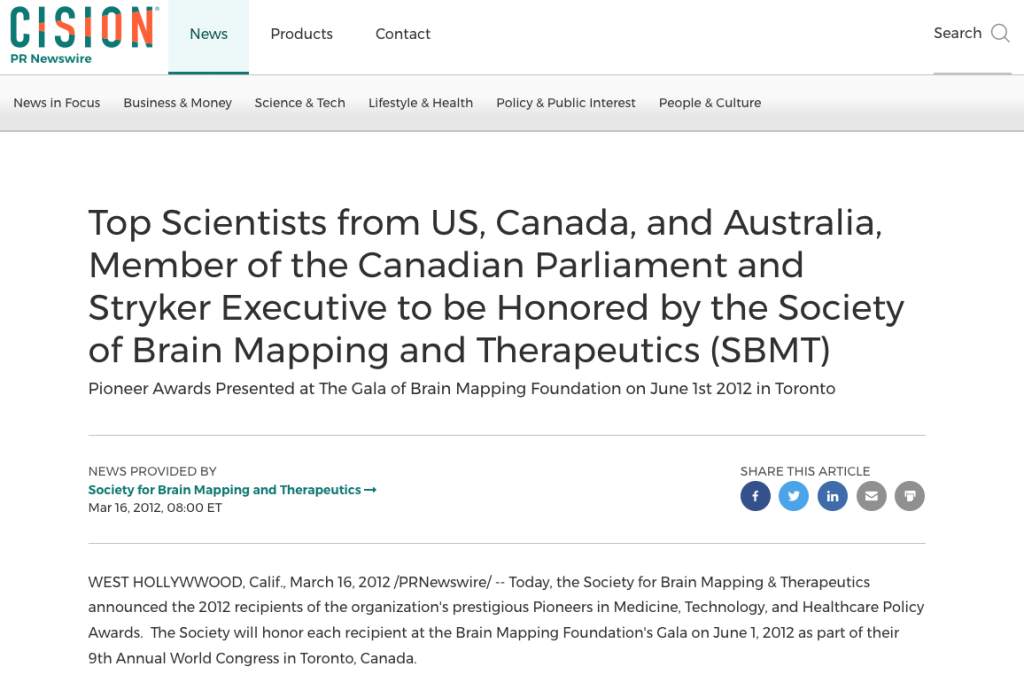
WEST HOLLYWWOOD, Calif., March 16, 2012 /PRNewswire/ — Today, the Society for Brain Mapping & Therapeutics announced the 2012 recipients of the organization’s prestigious Pioneers in Medicine, Technology, and Healthcare Policy Awards. The Society will honor each recipient at the Brain Mapping Foundation’s Gala on June 1, 2012 as part of their 9th Annual World Congress in Toronto, Canada. This year, the Society has selected Andres Lozano from the University of Toronto, Antonio Desalles from the University of California, Los Angeles and George Paxinos from the University of New South Wales to each receive a Pioneer in Medicine Award. The trio is on the forefront of Neuromodulation and Stereotactic-Radiosurgery. Their work has contributed to the understanding of the human brain and enabled scientists and surgeons across the globe to better treat neurological disorders such as Parkinson’s Disease. The Pioneer in Medicine Award is presented to individuals who have significantly contributed to scientific advancements in the fields of medicine and image guided therapy through a multi-disciplinary approach. Their groundbreaking contributions have led to the development of state-of- the-art technology. George Paxinos has pioneered stereotaxic (3D) mapping in animal models, which enabled neuroscientists and neurosurgeons around the globe to learn more about the basic science of the brain and push conventional boundaries in clinical neuroscience. Antonio Desalles has contributed significantly to the frameless stereotactic radiosurgery technology and broken new grounds in the use of Deep Brain Stimulation (DBS) for treatment of Post Traumatic Stress Disorder (PTSD). Andres Lozano is highly regarded as one of the authorities in the field of DBS. He has broken new grounds in treatment of Depression, Obesity and Alzheimer Diseases using DBS. “These scientists truly have advanced our understanding about the brain in a fundamental ways; their work has significantly contributed to introduction of new therapies for neurological disorders such as Parkinson’s Disease, Depression and Post Traumatic Stress Disorders,” states Babak Kateb, Founding Chairman of the Board of SBMT and President of Brain Mapping Foundation, and Director of National Center for Nano-Bio-Electronics, Research Scientist, Department of Neurosurgery, Cedars Sinai Medical Center, CA, USA. The Pioneer in Healthcare Policy Award is presented to lawmakers who have demonstrated visionary policies laws that have contributed to the advancement of science, technology, education, and medicine. The past recipient of this prestigious award include Congresswoman Gabrielle Giffords (2011), Senator Harry Reid (2010), Senator Ted Kennedy and Madam Speaker Pelosi (2009) and Governor Schwarzenegger (2008). This year Canadian MP, the Honorable Kirsty Duncan, will receive the Pioneer in Healthcare Policy Award for creating legislations, which has impacted research funding and better healthcare delivery in Canada. Her legislative work contributed significantly support for patients with neurological disorders in Canada and global collaboration in this area in order to expedite introduction of new therapies. “Not only do her sound healthcare policies impact millions of people in Canada, they also provide a model for present and future generations. We are truly honored to recognize one of the best advocates of brain research in Canada,” states Mike Chen, President of SBMT and Assistant Professor of Neurosurgery at City of Hope National Comprehensive Cancer Center, CA, USA. Kevin Lobo, Orthopedics Group President from Stryker Corporation, will be accepting a Pioneer in Technology Development from the Society on behalf of the Stryker Corporation, which has contributed to introduction of new devices, technologies and significantly contributed to therapies of neurological disorders. The Pioneer in Technology Award is presented to trailblazing companies and their CEOs/presidents who have facilitated the development of pioneering technologies through interdisciplinary approaches that have impacted diagnostics, treatment, and healthcare delivery in unprecedented ways. “The awards committee has been impressed with pioneering work done by Stryker Corporation to address health disparities. We hope Stryker continues its contribution to the field and support game-changing medical research with cutting edge technology that could one day turn into restorative solutions for patient with neurological disorders,” said Shouleh Nikzad, member of the board of directors of SBMT and Brain Mapping Foundation, Co-chair of the Award Committee, and Lead, Advanced UV/Vis/NIR Detector Arrays and Imaging Systems, and Nanoscience Group, Strategic Initiative on Gigapixel Focal Plane Arrays, NASA/Jet Propulsion Laboratory, California Institute of Technology, CA, USA. The theme of this year’s Congress is “Nano-Bio-Electronics,” focusing on the integration of nanotechnology, stem cell research, medical imaging and novel devices and further emphasizing multidisciplinary approach as an ultimate solution. The Congress features world-class speakers across multiple disciplines, drawing participants from around the globe to discuss brain and spinal cord science and technology. The 9th Annual World Congress is still accepting abstract proposals for the meeting’s workshops, lectures, and presentation sessions. Abstract submission is open now until March 25th 2012. For more information about 2012 speakers to register, or support of the 9th Annual World Congress of SBMT visit www.worldbrainmapping.org or call (310) 500-6196. For more information about the past Pioneer Award recipients of the Society for Brain Mapping and Therapeutics visit: https://www.worldbrainmapping.org/awardrecipients/ For more information about the Brain Mapping Foundation visit:http://www.brainmappingfoundation.org/ SOURCE Society for Brain Mapping and Therapeutics
Surgery for spinal cord injury within 24 hours improves outcomes
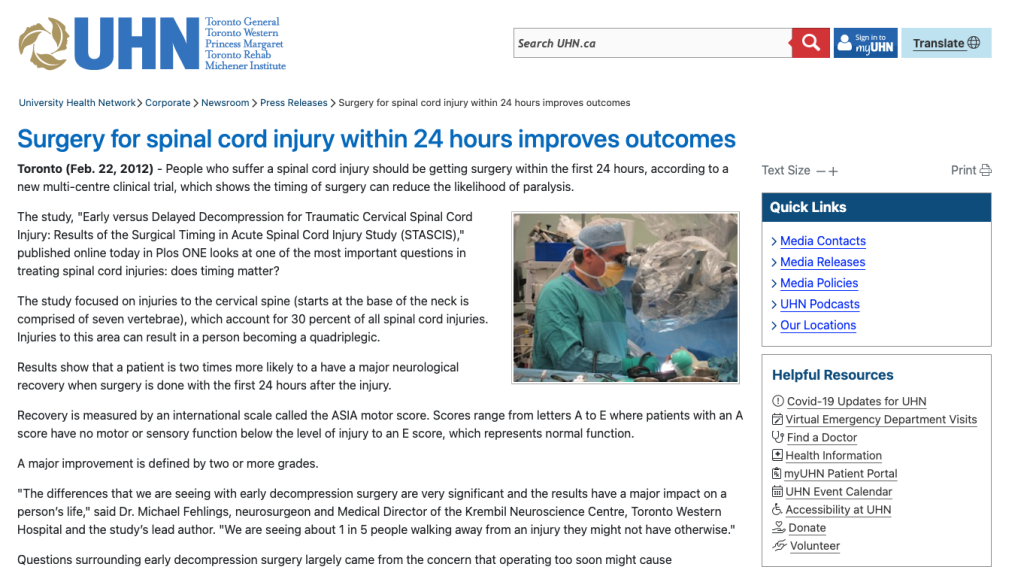
Surgery for spinal cord injury within 24 hours improves outcomes Toronto (Feb. 22, 2012) – People who suffer a spinal cord injury should be getting surgery within the first 24 hours, according to a new multi-centre clinical trial, which shows the timing of surgery can reduce the likelihood of paralysis. The study, “Early versus Delayed Decompression for Traumatic Cervical Spinal Cord Injury: Results of the Surgical Timing in Acute Spinal Cord Injury Study (STASCIS),” published online today in Plos ONE looks at one of the most important questions in treating spinal cord injuries: does timing matter? The study focused on injuries to the cervical spine (starts at the base of the neck is comprised of seven vertebrae), which account for 30 percent of all spinal cord injuries. Injuries to this area can result in a person becoming a quadriplegic. Results show that a patient is two times more likely to a have a major neurological recovery when surgery is done with the first 24 hours after the injury. Recovery is measured by an international scale called the ASIA motor score. Scores range from letters A to E where patients with an A score have no motor or sensory function below the level of injury to an E score, which represents normal function. A major improvement is defined by two or more grades. “The differences that we are seeing with early decompression surgery are very significant and the results have a major impact on a person’s life,” said Dr. Michael Fehlings, neurosurgeon and Medical Director of the Krembil Neuroscience Centre, Toronto Western Hospital and the study’s lead author. “We are seeing about 1 in 5 people walking away from an injury they might not have otherwise.” Questions surrounding early decompression surgery largely came from the concern that operating too soon might cause complications later on for the patient. But better surgical techniques and improved imaging capabilities over the last 20 years means that early surgery results in fewer complications. With consensus on early decompression growing among neurosurgeons, this study provides the scientific basis need to make policy changes that incorporates this evidence into a new standard of care for patients. “Since timing is such an important factor for treating spinal cord injuries we need to ensure that patients can get timely access to neurosurgical care,” said Dr. Fehlings. “This could mean the creation of neurosurgical centres of excellence, similar to stroke centres in Ontario.” There are 1,500 – 1,700 new injuries a year in Canada. Over a million people have an SCI in US in Canada and numbers are rising. According to the Rick Hansen Foundation, spinal cord injuries cost the system three billion dollars annually in Canada. Dr. Michael Fehlings is also a professor of neurosurgery at the University of Toronto. He holds the Krembil Chair in Neural Repair and Regeneration and is a McLaughlin Scholar in Molecular Medicine. About Krembil Neuroscience Centre The Krembil Neuroscience Centre (KNC), located at Toronto Western Hospital, is home to one of the largest combined clinical and research neurological facilities in North America. Since opening in 2001, KNC has been recognized as a world leader through its research achievements, education and exemplary patient care. The centre focuses on the advancement, detection and treatment of neurological diseases and specializes in movement disorders, dementias, stroke, spinal cord injury, blinding eye diseases, epilepsy and cancer-related conditions. For more information please visit www.krembil.com. About University Health Network University Health Network consists of Toronto General Hospital, Toronto Western Hospital, Princess Margaret Hospital and Toronto Rehabilitation Institute. The scope of research and complexity of cases at University Health Network has made it a national and international source for discovery, education and patient care. It has the largest hospital-based research program in Canada, with major research in cardiology, transplantation, neurosciences, oncology, surgical innovation, infectious diseases, genomic medicine and rehab. University Health Network is affiliated with the University of Toronto. Media Contact Phone: 416 340 4636Email: UHN.News@uhn.ca
U.S. and Canadian Scientists Form a Global Alliance for Nano-Bio-Electronics in Order to Rapidly Find Solutions for Neurological Disorders Such as Traumatic Brain Injury
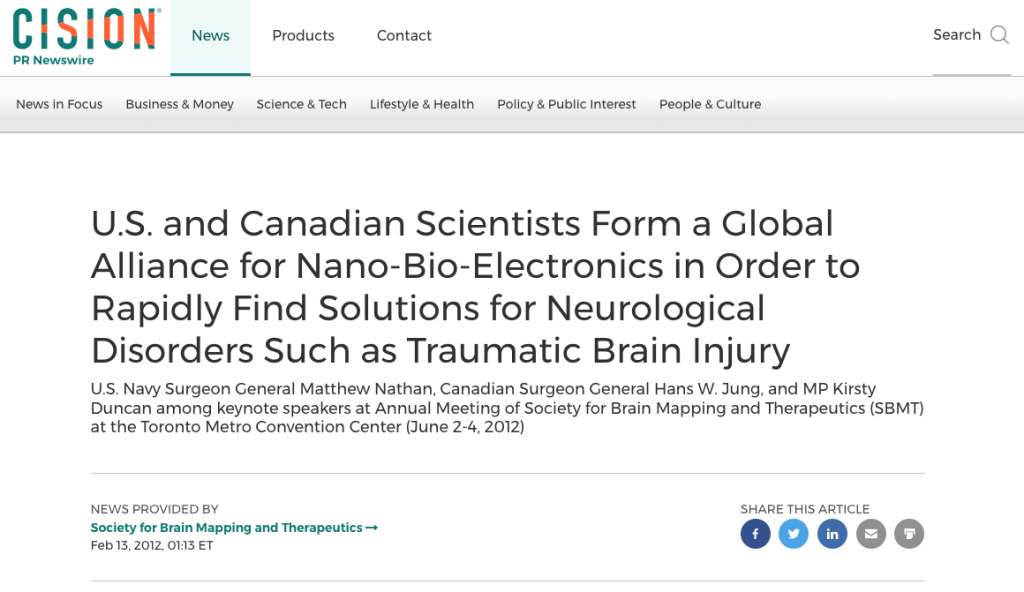
LOS ANGELES, Feb. 13, 2012 /PRNewswire/ — The Society for Brain Mapping and Therapeutics (SBMT) announced today that the organization will hold its 9th Annual World Congress on Brain, Spinal Cord Mapping, and Image Guided Therapy from June 2-4, 2012 in Toronto, Canada. The world’s top brain and spinal cord scientists and surgeons will converge on the Toronto Metro Convention Center to find solutions to some of the most difficult to treat neurological disorders, including traumatic brain and spinal cord injuries, Parkinson’s Disease, Alzheimer’s Disease, and neurological cancers. The 2012 World Congress of SBMT is jointly supported by the American Association of Neurological Surgeons, the Government of Canada, the University of Toronto, and MaRS innovation; it is endorsed by the International Society for Magnetic Resonance Imaging in Medicine. The theme of this year’s World Congress is “Nano-Bio-Electronics,” which focuses on the integration of nanotechnology, stem cell research, and biomedical engineering, and imaging of the brain and spinal cord to make progress in the fight against neurological diseases. The aim of the Congress is to provide a multidisciplinary forum for health professionals in the fields of neurosurgery, neurology, psychiatry, radiology, neuroscience, engineering, as well as policymakers, to collaborate as a global alliance to rapidly advance treatment of neurological disorders. “The meeting will help us kick start a unique and efficient consortium, which will unite scientists and consolidate resources in order to help us quickly come up with solutions for the devastating neurological diseases affecting millions and costing billions in the US alone,” said Babak Kateb, Chairman of the Board of SBMT, President of the Brain Mapping Foundation, and Director of the National Center for Nano-Bio-Electronics (NCNBE). Dr. Kateb states, “The purpose of the Nano-Bio-Electronic alliance is to facilitate integration of nanotechnology, Stem cell and cellular therapy with medical devices and imaging. This consortium will impact global biomedical science and healthcare delivery through national and international partnerships with governments, universities, leading organizations and industries.” Among the notable participants of the 2012 World Congress includes Canadian Surgeon General Hans W. Jung, U.S. Navy Surgeon General Matthew Nathan, and Canadian Parliament Member Kirsty Duncan. Dr. Duncan, an advocate for brain research in Canada and a global voice for neuroscience initiatives, stated “I am honored to participate in this important conference. It is vital that we work to enhance our understanding of brain health through research and collaboration.” She added, “We must also affirm our commitment to improving the quality of life of those who live with a brain condition and of their families and informal caregivers.” Toronto was chosen for this year’s meeting because of the city’s strong and globally-connected network of neuroscientists, biomedical engineers, and investors in the biomedical and nanotechnology fields. Michael Fehlings, chairman of the local organizing committee, Professor of Neurosurgery, and Director of the Neuroscience Program at the University of Toronto, said “The meeting will showcase Canadian and international neuroscience talent in a broad range of disciplines and will highlight the latest advances in imaging, molecular and cellular mechanisms, bioengineering and surgical intervention.” Parimal Nathwani, Vice President of MaRS Innovation, added, “Forums like this represent an excellent opportunity for reviewing technologies and supporting collaboration across different institutions for more effective translation and commercialization opportunity.” The 9th Annual World Congress is still accepting abstract proposals for the meeting’s workshops, lectures, and presentation sessions. Abstract submission is open now until March 15th 2012. For the full list of 2012 speakers to register, or support of the 9th Annual World Congress of SBMT on Brain, Spinal Cord Mapping, and Image-Guided Therapy, please visit www.worldbrainmapping.org or call (310) 500-6196. Society of Brain Mapping and TherapeuticsSBMT is a non-profit society organized for the purpose of encouraging basic and clinical scientists who are interested in areas of Brain Mapping and Intra-operative Surgical planning to improve the diagnosis, treatment and rehabilitation of patients afflicted with neurological disorders. This society promotes the public welfare and improves patient care through the translation of new technologies into life saving diagnostic and therapeutic procedures. The society is committed to excellence in education, and scientific discovery. The society achieves its mission through multi-disciplinary collaborations with government agencies, patient advocacy groups, educational institutes and private sector (industry) as well as philanthropic organization. www.IBMISPS.org University of Toronto Neuroscience ProgramThe University Of Toronto Faculty Of Medicine established the U of T Neuroscience Program (UTNP) as a new academic program and appointed Professor Michael G. Fehlings as its first Director on September 1, 2008. The UTNP is a robust, integrated and collaborative academic program in neurosciences that leverages the unparalleled health science network at the University of Toronto, which includes U of T’s many departments and institutes, health science faculties, 9 fully-affiliated research hospitals and 20 community-affiliated hospitals and clinical care sites. MaRS InnovationMaRS Innovation provides an integrated commercialization platform that harnesses the economic potential of the exception discovery pipeline of 16 leading academic institutions in Ontario. MaRS Innovation is a not-for-profit organization with an independent industry- led board of directors, funded through the Government of Canada’s Networks of Centres of Excellence, the Province of Ontario through the Ministry of Research and Innovation, and contributions of its member institutions. Designed to enhance the commercial output of Toronto’s outstanding scientific research cluster, MaRS Innovation will make a significant contribution to Canada’s economic outlook and the quality of life for Canadians and others around the world. MaRS Innovation will advance commercialization through industry partnerships, licensing and company creation. The MaRS Innovation mission is to put Canada on the global innovation stage, by better connection of research with industry and strengthening Canada’s competitive capacity in the knowledge based business – in short, to launch a new generation of robust high growth Canadian companies. www.marsinnovation.com American Association of Neurological SurgeonsThe American Association of Neurological Surgeons (AANS) is the organization that speaks for all of neurosurgery. The AANS is dedicated to advancing the specialty of neurological surgery in order to promote the highest quality of patient care. http://aans.org SOURCE Society for Brain Mapping and Therapeutics
Timing for clinical trials for stem cell therapy in spinal cord injuries is right
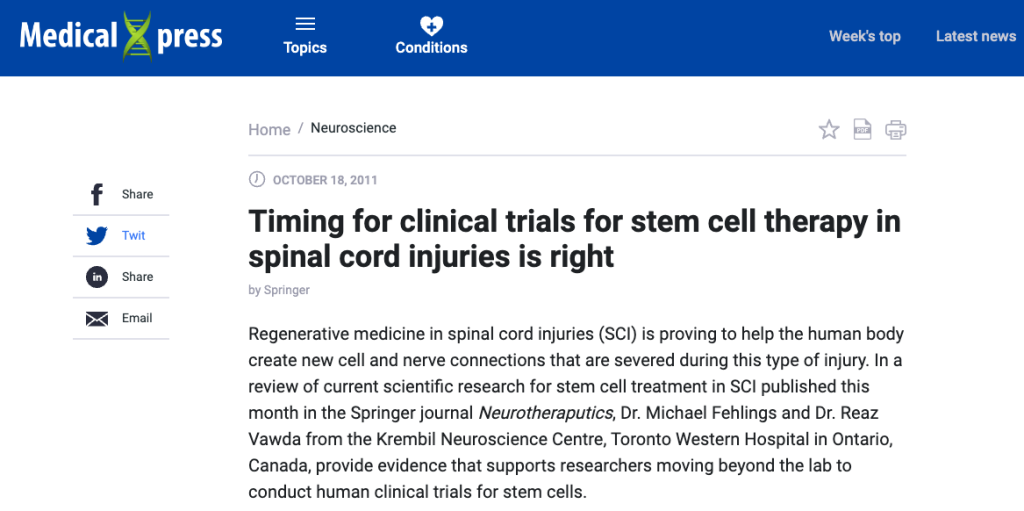
OCTOBER 18, 2011 Timing for clinical trials for stem cell therapy in spinal cord injuries is right by Springer Regenerative medicine in spinal cord injuries (SCI) is proving to help the human body create new cell and nerve connections that are severed during this type of injury. In a review of current scientific research for stem cell treatment in SCI published this month in the Springer journal Neurotheraputics, Dr. Michael Fehlings and Dr. Reaz Vawda from the Krembil Neuroscience Centre, Toronto Western Hospital in Ontario, Canada, provide evidence that supports researchers moving beyond the lab to conduct human clinical trials for stem cells. Spinal cord injuries remain one of the most difficult conditions to overcome. Despite the advances made in surgical interventions, drugs and rehabilitation programs, the cascade of damage that ultimately affects the body at the cellular level cannot be reversed. Stem cell research brings tremendous hope to those who remain paralyzed after such a devastating injury. But according to Dr. Fehlings, patients are not able to realize the potential benefits of stem cell therapy because research is largely stuck in the laboratory. “With the exception of a few clinical trials, current research is stalled at the animal model stage,” said Dr. Fehlings. “Scientists from around the world have demonstrated as much as they can in lab models that stem cells have an impact on spinal cord injuries and can be transplanted into patients. Now we need the support and coordination of regulatory bodies to move this science forward.” The study critically evaluates 11 different cell types/sources and the evidence justifying their use. For example, BMSCs (Bone marrow stromal cells ) have an established safety record, as well as a beneficial effect after thoracic SCI. Glial restricted progenitors (GRPs) and oligodendrocytic progenitors (OPCs) are described to have a track record that favours the continuation of more clinical trials and Neural Progenitor Cells (NPC), of which one line of immortalized foetal NPCs has been subjected to extensive pre-clinical safety testing, may have potential benefits. Spinal cord injuries not only cause life-long disability and carry major psychological effects, injuries to the cervical spine (neck) have a mortality rate of 10 percent in the first year following injury and an expected lifespan of only 10 – 15 years post injury. Some of the evidence for increasing and expanding clinical trials from the study includes: “At this time, a strong patient advocacy base would likely help provide momentum to help translate current research into clinical applications,” said Dr. Fehlings. “Moving forward, all clinical trails must involve peer-reviewed assessment, regulation, independent monitoring, duplication, transparency and accurate record keeping of the every step of the process.” Dr. Fehlings acknowledges that no clinical intervention is 100 percent risk free and uses the examples of other novel therapies such as bone marrow transplantation and the polio vaccine to illustrate how science has forged ahead successfully, despite setbacks along the way. More information: Fehlings M, Vawda R (2011) Cellular Treatments for Spinal Cord Injury: The Time is Right for Clinical Trials. Neurotherapeutics. DOI 10.1007/s13311-011-0076-7 Provided by Springer
Researchers Rescue Nerve Cells in Spinal Cord Dysfunction
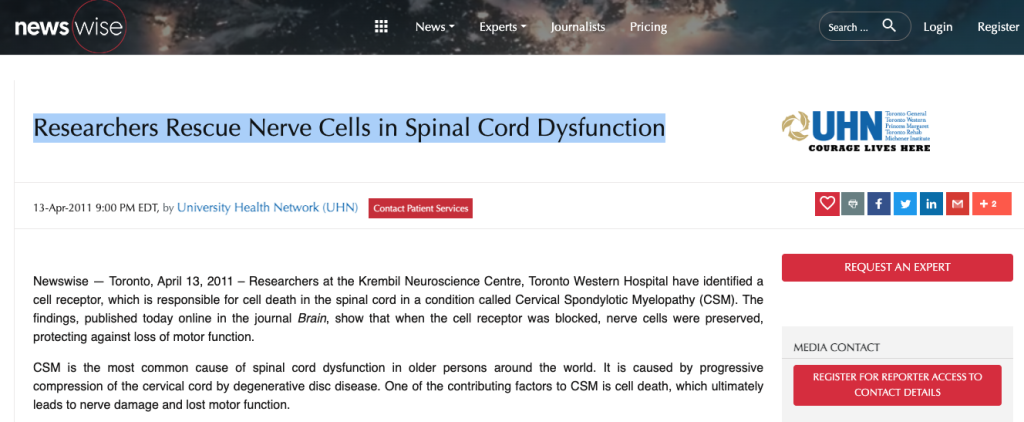
Newswise — Toronto, April 13, 2011 – Researchers at the Krembil Neuroscience Centre, Toronto Western Hospital have identified a cell receptor, which is responsible for cell death in the spinal cord in a condition called Cervical Spondylotic Myelopathy (CSM). The findings, published today online in the journal Brain, show that when the cell receptor was blocked, nerve cells were preserved, protecting against loss of motor function. CSM is the most common cause of spinal cord dysfunction in older persons around the world. It is caused by progressive compression of the cervical cord by degenerative disc disease. One of the contributing factors to CSM is cell death, which ultimately leads to nerve damage and lost motor function. A cell receptor is a molecule on the surface of the cell that instructs the cell to die when it has been injured. Using animal models and human spinal cord tissue, Dr. Michael Fehlings, the lead author of the study, discovered that the activation of the cell receptor Fas is a contributing factor to cord compression and nerve cell death. When this Fas receptor was blocked in animal models with CSM, motor function improved and cell-death was reduced. “This novel evidence suggests that the Fas receptor can be targeted in people with CSM to stop neural degeneration,” said Dr. Fehlings. “This exciting discovery can lead to the development of a therapy that will compliment surgical decompression and ultimately lead to neuroprotective theraputics for people suffering with CSM.” The average age for patients to be diagnosed with CSM is 50 years old. Symptoms often develop insidiously and are characterized by neck stiffness, arm pain, numbness in the hands, and weakness of the hands and legs. Left untreated, CSM could result in paralysis. Previous studies by Dr. Fehlings have shown that surgery is currently the best option to address the symptoms of CSM. Dr. Michael Fehlings is the Medical Director of the Krembil Neuroscience Centre and heads the Spinal program at the Toronto Western Hospital. In addition, Dr. Fehlings is a professor of neurosurgery at the University of Toronto; is a scientist at the McEwen Centre for Regenerative Medicine and a McLaughlin Scholar in Molecular Medicine. About Krembil Neuroscience CentreThe Krembil Neuroscience Centre (KNC), located at Toronto Western Hospital, is home to one of the largest combined clinical and research neurological facilities in North America. Since opening in 2001, KNC has been recognized as a world leader through its research achievements, education and exemplary patient care. The centre focuses on the advancement, detection and treatment of neurological diseases and specializes in movement disorders, dementias, stroke, spinal cord injury, blinding eye diseases, epilepsy and cancer-related conditions.For more information please visit www.krembil.com About University Health Network University Health Network consists of Toronto General, Toronto Western and Princess Margaret Hospitals. The scope of research and complexity of cases at University Health Network has made it a national and international source for discovery, education and patient care. It has the largest hospital-based research program in Canada, with major research in cardiology, transplantation, neurosciences, oncology, surgical innovation, infectious diseases, and genomic medicine. University Health Network is a research hospital affiliated with the University of Toronto. For more information please visit www.uhn.ca
U.S. Representative Gabrielle Giffords and NASA Scientist Dr. Minoru Freund to Accept Beacon Award for Courage and Dedication
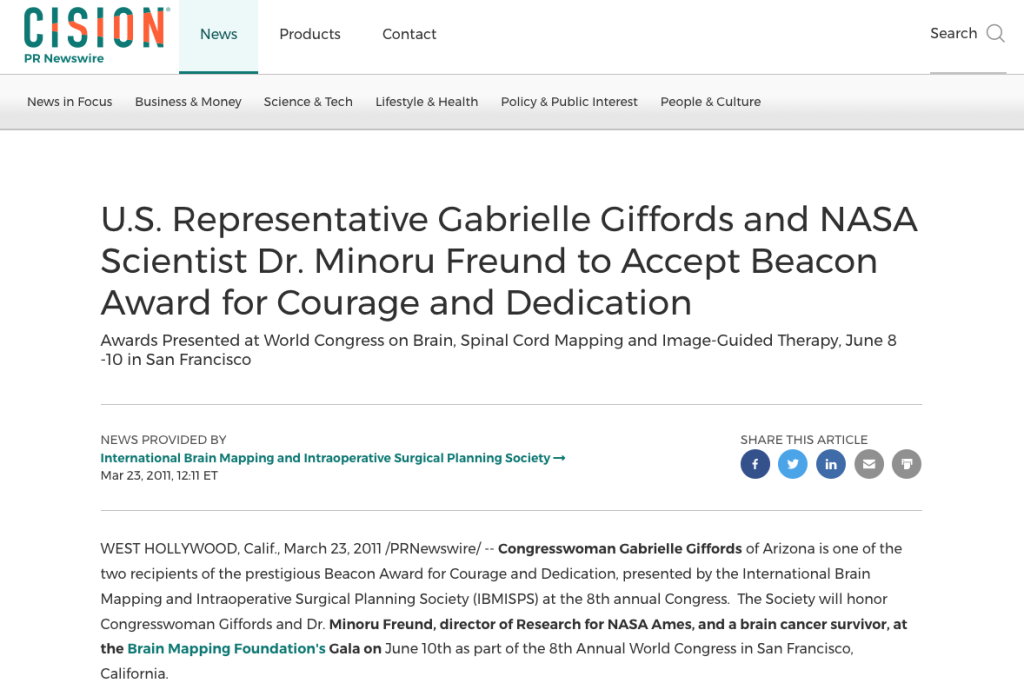
NEWS PROVIDED BYInternational Brain Mapping and Intraoperative Surgical Planning Society Mar 23, 2011, 12:11 ET SHARE THIS ARTICLE WEST HOLLYWOOD, Calif., March 23, 2011 /PRNewswire/ — Congresswoman Gabrielle Giffords of Arizona is one of the two recipients of the prestigious Beacon Award for Courage and Dedication, presented by the International Brain Mapping and Intraoperative Surgical Planning Society (IBMISPS) at the 8th annual Congress. The Society will honor Congresswoman Giffords and Dr. Minoru Freund, director of Research for NASA Ames, and a brain cancer survivor, at the Brain Mapping Foundation’s Gala on June 10th as part of the 8th Annual World Congress in San Francisco, California. The theme of this year’s Congress, to be held June 8 -10, is Nano-Bio-Electronics, focusing on the integration of nanotechnology, stem cell research, medical imaging and devices. This CME-accredited scientific program features world-class speakers across multiple disciplines, drawing participants from around the globe to discuss brain and spinal cord science and technology. “We are honored to host this extremely important World Congress that helps merge the basic bioengineering sciences — along with imaging and clinical medicine — in a world-class environment of translational research at UCSF,” stated Mitchel Berger, Professor and Chairman of Neurosurgery Department at UCSF. The Beacon Award is presented annually to individuals demonstrating extraordinary courage and dedication for increasing awareness about neurological diseases, and for patients and their families who have exceeded expectations in fighting neurological disorders with unprecedented courage. “Dr. Geoffrey Ling, a member of our Society, was one of the neurologists who treated the Congresswoman,” says Babak Kateb, Founding Chairman of Board of Directors of IBMISPS, Brain Mapping Foundation and National Center for Nano-Bio-Electronics. “Patients are our best teachers. They help us unlock mysteries of diseases, advance the field and amaze us with their resilience, courage and dedication in fighting neurological disorders and injuries.” Giffords and Freund join past recipients including The Honorable Tammy Duckworth, Assistant Secretary of VA; SGM Colin R. Rich; ABC News Anchor Bob Woodruff; and Oscar Winner Dustin Hoffman. “On behalf of Congresswoman Giffords, we’re honored that she’s being recognized with this special award that acknowledges both her strength and will to fight her traumatic brain injury,” says Pia Carusone, Chief of Staff for Giffords. “Her extraordinary recovery is a testament to the multidisciplinary work of physicians and scientists who have been dedicating their life toward finding effective treatments for neurological disorders that gives hope to other patients.” The Society also will recognize Dr. Patrick Soon-Shiong with IBMISPS’s Pioneer in Medicine Award, and highlight the importance of policymakers through its Pioneer in Healthcare Policy award. The Society’s 2011 Humanitarian Award will be presented to Drs. Rocco Armonda and Henry Marsh. Keynote speakers will include: Secretary of Health and Human Services, Kathleen Sebelius; George Peach Taylor, Jr., Assistant Secretary of Defense for Health Affairs, Department of Defense; Vice Admiral Adam M. Robinson, Jr., Vice Admiral, 36th Surgeon General of the Navy, Chief Navy’s Bureau of Medicine and Surgery; Kaigham J. Gabriel, Deputy Director of Defense Advanced Research Project Agency; Dr. Pete Worden, Director of NASA Ames Research Center; and Ramon Lugo III, Director of NASA Glenn Research Center. For more information, to register, participate or sponsor the 8th Annual World Congress on Brain, Spinal Cord Mapping and Image-Guided Therapy, visit www.worldbrainmapping.org. To learn more about IBMISPS visit: www.IBMISPS.org SOURCE International Brain Mapping and Intraoperative Surgical Planning Society
Study: Retinal imaging indicates presymptomatic Alzheimer’s

TriMed Staff | July 01, 2010 | Molecular Imaging Noninvasive retinal imaging may be helpful in the early diagnosis, intervention and monitoring of Alzheimer’s disease (AD), as the beta-amyloid (AB) plaques characteristic of the disease first appear in the eyes, according to a study published online June 13 in NeuroImage. Since existing noninvasive brain-imaging technologies cannot provide sufficient detail about changes within cells and cell communication and are limited in both specificity and resolution, the most definitive diagnosis of AD currently comes after an autopsy. “The retina as an extension of the brain portrays an appealing target for a live, noninvasive optical imaging of AD if disease pathology is manifested there,” wrote Maya Koronyo-Hamaoui, PhD, a research scientist and assistant professor of neurosurgery at the Maxine Dunitz Neurosurgical Research Institute at Cedars-Sinai Medical Center in Los Angeles, and her colleagues. Koronyo-Hamaoui and colleagues first identified retinal AB plaques in the eyes of eight AD patients, with five patients suspected of early stage disease based on brain pathology and clinical reports. The plaques were undetectable in five age-matched non-AD individuals. Next, the authors utilized a noninvasive optical imaging technique to detect retinal plaques in 18 live laboratory mice genetically modified to model the human disease and compared the results to 10 mice without the plaques. In the 18 genetically modified mice, detection of plaques followed administration of curcumin, a plaque-labeling fluorochrome. The researchers found that retinal plaques were detectable earlier with their optical imaging approach – while still at a pre-symptomatic stage and before the plaque appeared in the brain and accumulated with disease progression. “Systemic administration of curcumin allowed noninvasive optical imaging of retinal AB plaques in vivo with high resolution and specificity and plaques were undetectable in mice [who were not genetically modified to model AD],” said the authors. “Our discovery of AB specific plaques in retinas from AD patients, and the ability to noninvasively detect individual retinal plaques in live AD mice establishes the basis for developing high-resolution optical imaging for early AD diagnosis, prognosis, assessment and response to therapies,” concluded the researchers. The study, which was conducted at Cedars-Sinai, is slated to be presented at the Alzheimer’s Association International Conference on Alzheimer’s disease on July 13 in Honolulu.
Alzheimer’s Diagnosis by Retina? Imaging of retinal plaques may hold promise for assessing patients with Alzheimer’s
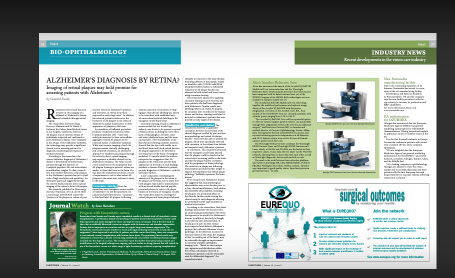
Hallmark Alzheimer’s disease changes found in retinas of humans and imaged in live animals
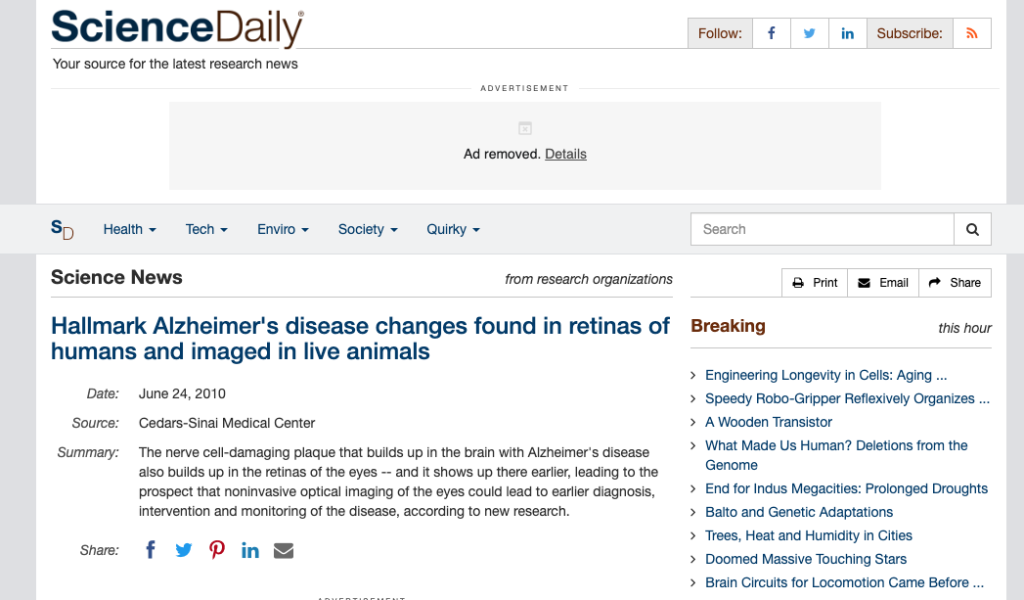
The nerve cell-damaging plaque that builds up in the brain with Alzheimer’s disease also builds up in the retinas of the eyes — and it shows up there earlier, leading to the prospect that noninvasive optical imaging of the eyes could lead to earlier diagnosis, intervention and monitoring of the disease, according to new research. Scientists discovered characteristic amyloid plaques in retinas from deceased Alzheimer’s disease patients and used a noninvasive optical imaging technique to detect retinal plaques in live laboratory mice genetically modified to model the human disease. The combined results suggest the possibility that noninvasive retinal imaging may be helpful in early diagnosis of the disease. The research was conducted by a team of scientists at Cedars-Sinai Medical Center in collaboration with colleagues from the Weizmann Institute of Science in Israel and the University of Southern California. Results were published online June 13 in the journal NeuroImage, and related findings will be presented July 13 at the Alzheimer’s Association International Conference on Alzheimer’s Disease. Alzheimer’s disease is a devastating condition that is becoming more prevalent worldwide as the baby-boom generation advances into its senior years, but there is no conclusive, noninvasive way to diagnose it. Previous studies have suggested that changes in the brain may begin years or even decades before symptoms occur — emphasizing the need for earlier, reliable detection for early therapeutic intervention to achieve effective remedy. The new study suggests the possibility of monitoring Alzheimer’s disease through a simple retinal imaging approach. Abnormal deposits in the brain called beta-amyloid plaques, which damage cells and interrupt cell-to-cell communications, are recognized as a hallmark sign of the disease. However, because existing noninvasive brain-imaging technologies cannot provide sufficient detail about these changes, the most definitive diagnosis of Alzheimer’s disease comes after an autopsy. The research team considered the retina a better target for noninvasive imaging of Alzheimer’s disease because it is readily accessible and, unlike other components of the eye, it is part of the central nervous system, having a direct connection and thus many similarities with the brain. Previous studies have documented non-specific visual disturbances, eye disorders and certain types of retinal abnormalities occurring with Alzheimer’s disease and other neurodegenerative conditions, but this is the first to identify human retinal plaque deposits that could provide a specific diagnostic marker of Alzheimer’s disease. Among the new findings: Together, the results offer the first evidence for the existence of Alzheimer’s-specific plaques in the retina of human patients and the ability to detect individual plaques in live mouse models, creating a strong basis for future research building on these findings. According to the authors, these studies establish the potential of direct retinal beta-amyloid plaque imaging in live subjects as a tool for early Alzheimer’s disease diagnosis and prognosis, as well as assessment of therapies. Specialists in neurosurgery, ophthalmology, imaging systems, neuroimmunology, pathology, neurology and biomedical engineering collaborated on these studies, which were conducted at Cedars-Sinai Medical Center by scientists from Cedars-Sinai, the Weizmann Institute of Science in Israel, and the University of Southern California. The journal article’s first authors are Maya Koronyo-Hamaoui, Ph.D., a research scientist and assistant professor of neurosurgery at Cedars-Sinai’s Maxine Dunitz Neurosurgical Institute and a principal investigator in the Neuroimmunology Laboratory at Cedars-Sinai; and Yosef Koronyo, M.Sc., LL.B., a research associate in the departments of Surgery and Neurosurgery at Cedars-Sinai. Michal Schwartz, Ph.D., visiting professor in the Department of Neurosurgery at Cedars-Sinai, and the Ilze and Maurice Professorial Chair of Neuroimmunology at the Weizmann Institute of Science in Rehovot, Israel, is a senior author. The work was supported by the Marciano Family Foundation, the Maxine Dunitz Neurosurgical Institute, the U.S. Navy Bureau of Medicine and Surgery, the National Eye Institute, the Winnick Family Foundation, and a National Institute on Aging grant to the University of Southern California Alzheimer’s Disease Research Center.
